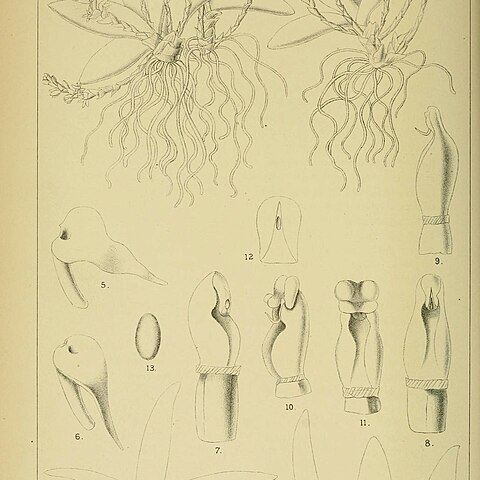Plants to 50 mm tall; stemless; roots thin, numerous, to 50 mm long; leaves succulent, 3-10, laterally compressed with upper margins fused, overlapping to form a fan, to 30 mm long and 8 mm wide. Inflorescences ascending, to 80 mm long, with 8-16 flowers; sheaths 3 mm long, subimbricate, upper bracts largely obscuring the flowers, acute, ovate, to 4 mm long. Flowers white, almost distichous, to 4 mm long, with a slightly foetid smell. Sepals subequal, narrowly lanceolate, acute, 4 x 1 mm; median sepal somewhat wider than the laterals; lateral sepals with basal lobes c. 1 mm in diameter and fused to the spur. Petals similar to sepals. Lip narrowly triangular, acute, 2.5 x 1 mm; spur descending, cylindrical, apically rounded, 1.5 mm long. Gynostemium 1 mm tall; anther-cap square.
Leaves 5–8, arranged in a fan; lamina 3–5 × 0.5–1 cm, sword-shaped, bilaterally flattened, obtuse, with no groove along the upper surface, glossy green.
Lip 2–3 × 1 mm, obscurely 3-lobed; mid-lobe oblong, acute, recurved; side lobes rounded; spur 1–2 mm long, conical, obtuse, pointing forwards.
Bracts 3–4 mm long, ovate, acute, green-brown, imbricate, partly covering the flowers.
Inflorescences arising at base of plant, 2.5–6 cm long, densely many-flowered.
Sepals 3–4 × 1–1.5 mm, oblong; petals similar but slightly smaller.
Dwarf epiphytic herb; stem up to 2 cm long, rarely longer.
Flowers white, the spur greenish.
Pedicel and ovary 1–2 mm long.
Column 0.6–0.8 mm long.

